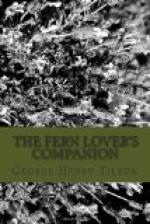Aspidium cristatum. THELYPTERIS CRISTATA
Dryopteris cristata. Nephrodium cristatum
Fronds one to two feet long, linear-oblong or lanceolate, pinnate, acute. Pinnae two to three inches long, broadest at the base, triangular-oblong, or the lowest triangular. Divisions oblong, obtuse, finely serrate or cut-toothed, those nearest the rachis sometimes separate. Fruit-dots large, round, half way between the midvein and the margin. Indusium smooth, naked, with a shallow sinus.
The short sterile fronds, though spreading out gracefully, are conspicuous only in winter; while the fertile fronds, tall, narrow and erect, are found only in summer.
It is one of our handsomest evergreen ferns and even the large sori, with their dark spore cases and white indusia, are very attractive. The fertile pinnae have a way of turning their faces upward toward the apex of the frond for more light. In moist land, Canada to Kentucky.
Var. Clintonianum. Clinton’s Wood Fern. Resembles the type, but is in every way larger. Divisions eight to sixteen pairs. Fruit-dots near the midvein, the sides of the sinus often overlapping. South central Maine to New York and westward. “Rare in New England attaining its best development in western sections.” (Dodge.) Mt. Toby, Mass., Hanover, N.H. July. Fine for cultivation.
[Illustration: Crested Shield Fern. Aspidium cristatum (Reading, Mass., Kingman)]
[Illustration: The Crested Shield Fern. Aspidium cristatum]
[Illustration: Clinton’s Wood Fern. Aspidium cristatum, var. Clintonianum (Gray Herbarium)]
CRESTED MARGINAL FERN
Aspidium cristatum X marginale
Both the crested fern and Clinton’s fern appear to hybridize with the marginal shield fern with the result that the upper part of the frond is like marginale and the lower like cristatum, including the veining and texture.
This form was discovered by Raynal Dodge, verified by Margaret Slosson and described by Geo. E. Davenport, who had a small colony under cultivation in his fern garden at Medford, Mass., and to him the writer and other friends are indebted for specimens.
Found occasionally throughout New England and New Jersey. Other supposed hybrids have been found between the marginal shield and the spinulose fern and its variety intermedium, and with Goldie’s fern; also between the crested fern, including Clinton’s variety and each of the others mentioned; and, in fact, between almost all pairs of species of the wood ferns, although we do not think they have been positively verified. Still other species of ferns are known to hybridize more or less, as we saw in the case of Scott’s spleenwort.
[Illustration: Crested Marginal Fern. A Hybrid. Aspidium Cristatum X marginale (Fernery of Geo. E. Davenport)]




